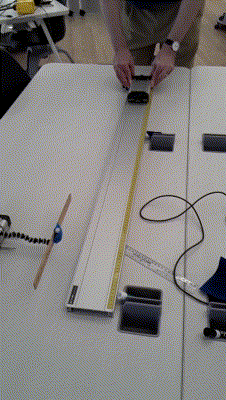Classical Relativity
Objective
Measure the velocity of a cart in the lab (rest) frame by measuring its velocity relative to another moving object with a known velocity.

Resources
- Cart track, magnetic bumper
- 2 carts, one with mounted camera and ruler attached to arm
- Tracker motion analysis software
Explanation
Everyday experience seems to indicate that velocities add in a simple algebraic manner, meaning that for two objects moving in opposite directions at speeds v_1 and v_2, an observer on one of the objects will observe the other object moving at a velocity v_1+v_2. Einstein showed that this is actually not the way the universe works at all! For example, if two objects move in opposite directions at 75% the speed of light in some reference frame, it would violate physical laws for them to be moving away from each other at greater than the speed of light. However, for low velocities simple addition of velocities works perfectly well.
Setup
Put the cart without the camera on the track and launch it by holding it fast against the repulsive magnetic bumper and releasing it as shown above. This should provide a fairly consistent launch velocity. Determine the velocity of this launch method. Set the cart with the camera next to the track so that the camera points at the track, set it to record and give it a gentle push parallel to the track. Launch the other cart while the camera cart is still rolling.
Analysis Questions
- What is the velocity of the cart on the track relative to the camera cart?
- What is the velocity of the camera cart relative to the table?
- What is the uncertainty in your result? Explain how you determined this.